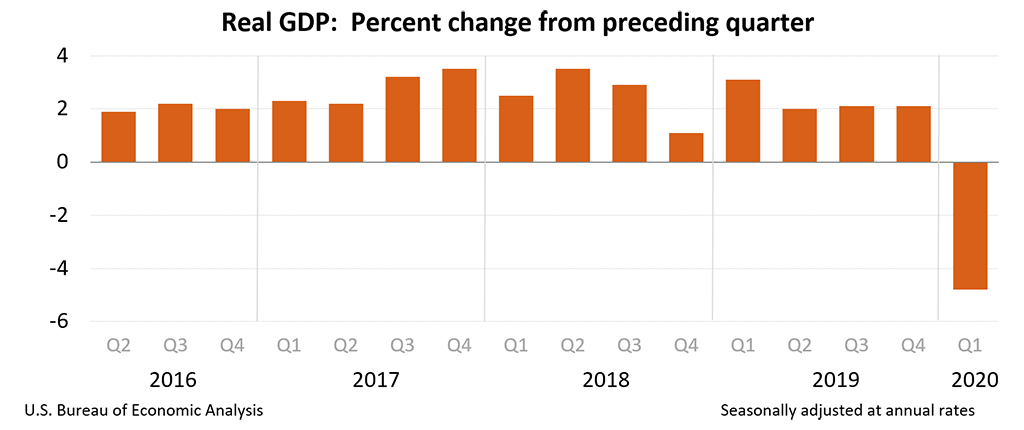
BEA News: Gross Domestic Product, 1st Quarter 2020 (Advance Estimate)
The U.S. Bureau of Economic Analysis (BEA) has issued the following news release today:
Real gross domestic product (GDP) decreased 4.8 percent in the first quarter of 2020, according to the “advance” estimate released by the Bureau of Economic Analysis. In the fourth quarter of 2019, real GDP increased 2.1 percent.
The full text of the release on BEA’s website can be found at:
https://www.bea.gov/news/2020/gross-domestic-product-1st-quarter-2020-advance-estimate
Real gross domestic product (GDP) decreased at an annual rate of 4.8 percent in the first quarter of 2020 (table 1), according to the “advance” estimate released by the Bureau of Economic Analysis. In the fourth quarter of 2019, real GDP increased 2.1 percent.
The GDP estimate released today is based on source data that are incomplete or subject to further revision by the source agency (see “Source Data for the Advance Estimate” on page 2). The “second” estimate for the first quarter, based on more complete data, will be released on May 28, 2020.
/sites/default/files/files/bea-data-1%20Qu%202020_chart-01.png

Coronavirus (COVID-19) Impact on the Advance First-Quarter 2020 GDP Estimate
The decline in first quarter GDP was, in part, due to the response to the spread of COVID-19, as governments issued “stay-at-home” orders in March. This led to rapid changes in demand, as businesses and schools switched to remote work or canceled operations, and consumers canceled, restricted, or redirected their spending. The full economic effects of the COVID-19 pandemic cannot be quantified in the GDP estimate for the first quarter of 2020 because the impacts are generally embedded in source data and cannot be separately identified. For more information, see the Technical Note
The decrease in real GDP in the first quarter reflected negative contributions from personal consumption expenditures (PCE), nonresidential fixed investment, exports, and private inventory investment that were partly offset by positive contributions from residential fixed investment, federal government spending, and state and local government spending. Imports, which are a subtraction in the calculation of GDP, decreased (table 2).
The decrease in PCE reflected decreases in services, led by health care, and goods, led by motor vehicles and parts. The decrease in nonresidential fixed investment primarily reflected a decrease in equipment, led by transportation equipment. The decrease in exports primarily reflected a decrease in services, led by travel.
Current‑dollar GDP decreased 3.5 percent, or $191.2 billion, in the first quarter to a level of $21.54 trillion. In the fourth quarter, GDP increased 3.5 percent, or $186.6 billion (tables 1 and 3).
The price index for gross domestic purchases increased 1.6 percent in the first quarter, compared with an increase of 1.4 percent in the fourth quarter (table 4). The PCE price index increased 1.3 percent, compared with an increase of 1.4 percent. Excluding food and energy prices, the PCE price index increased 1.8 percent, compared with an increase of 1.3 percent.
Personal Income and Outlays
Current-dollar personal income increased $95.2 billion in the first quarter, compared with an increase of $144.1 billion in the fourth quarter. The deceleration was more than accounted for by a deceleration in compensation that was partly offset by an acceleration in personal current transfer receipts (table 8).
Disposable personal income increased $76.7 billion, or 1.9 percent, in the first quarter, compared with an increase of $123.7 billion, or 3.0 percent, in the fourth quarter. Real disposable personal income increased 0.5 percent, compared with an increase of 1.6 percent.
Personal outlays decreased $253.5 billion, after increasing $118.8 billion. The decrease was mainly accounted for by a decrease in PCE.
Personal saving was $1.60 trillion in the first quarter, compared with $1.27 trillion in the fourth quarter. The personal saving rate—personal saving as a percentage of disposable personal income—was 9.6 percent in the first quarter, compared with 7.6 percent in the fourth quarter.
Source Data for the Advance Estimate
Information on the source data and key assumptions used in the advance estimate is provided in a Technical Note that is posted with the news release on BEA’s Web site. A detailed “Key Source Data and Assumptions” file is also posted for each release. For information on updates to GDP, see the “Additional Information” section that follows.
Upcoming Annual Update of the National Income and Product Accounts
BEA will release results from the 2020 annual update of the National Income and Product Accounts on July 30, 2020, in conjunction with the advance estimate of GDP for the second quarter of 2020. For estimates of real GDP and its major components, the span of the update will cover the most recent five years (2015-2019) and the first quarter of 2020. Estimates of income and saving will be subject to revision from 1999 through the first quarter of 2020. More information on the 2020 annual update will be included in the forthcoming May Survey of Current Business article, “GDP and the Economy.”
* * *
Next release, May 28, 2020 at 8:30 A.M. EDT
Gross Domestic Product, First Quarter 2020 (Second Estimate)
Corporate Profits, First Quarter 2020 (Preliminary Estimate)
